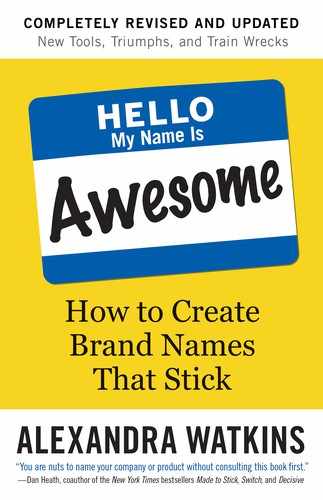PREFACE
Pop quiz!
When someone sees your new brand name, how do you want them to react?
A. Exclaim, “I freakin’ love it!”
B. Struggle to explain it, as if they’re reading hieroglyphics
C. Go back to looking at their phone
D. Throw up a little bit in their mouth
Obviously, you should be shooting for choice A (for Awesome). Your brand name makes a critical first impression. Even more than your shoes.
How many times will someone see, say, or hear the name of your brand in its lifetime? Do the math. The number of impressions is incalculable.
No other investment you’ll make in your business will last longer or get used more than your name. Getting it wrong can have painful consequences.
Just like jumping into a relationship before you really get to know someone, you may not discover the faults of a poorly chosen name right away. You’ll be too caught up in everything else you need to do to launch a new product or company. It won’t be until after you’ve started to build a future together that you realize your name “has issues.” And you’ll be forced to find ways to justify it. Like the bizarrely named baby clothing company Speesees. Here’s how they explained the idiotic spelling: “s-p-e-e-s-e-e-s is the way a baby would spell species if a baby could spell.” (Really? Really.)
I don’t want you to make a decision you will forever regret. Luckily, when you read this book, you will no longer be oblivious to the obvious.
The eye-opening stories here will help you avoid countless unforeseen naming pitfalls. You’ll read what happened to companies that thought they had a creative name but later realized it was a mistake. Like Bawte, whose name, a bastardized spelling of the word bought, could also be misheard as the word bot, both by humans and bots. Or American Scrap Metal, which may have had its domain name, americanscrapmetal.com, emblazoned on everything from trucks to T-shirts before they noticed it could be read as “Americans Crap Metal.”
As the Chief Executive Boss Lady of the naming firm Eat My Words, I’ve been involved in hundreds of naming projects over the past two decades. This book is packed with the most important information that you need to know. I sure wish I had known everything in the book when I was starting out.
You’ll learn how to create love-at-first-sight names that are so awesome that people will want to buy merchandise featuring it. Imagine that. Someone paying you to advertise your brand!
I’ll show you how to come up with dozens of creative ideas. Coming up with names will no longer be frustrating or daunting. It will be easy and exciting. By simply following my framework, you will succeed beyond your imagination.
If you want more assurance that this book will help you create awesome names, consider the story of Janice Pappas, a SAT math tutor who read Hello, My Name Is Awesome. She studied the book cover to cover, then took a crack at the Ultimate Dream Job Challenge (found on the EatMyWords.com website). Countless amateurs have taken the test over the past 14 years with only a handful being good enough to get hired. Statistically, Janice had a better chance of winning the Hunger Games. (I rarely see any new names that melt my butter.) Janice aced the test, submitting some of the most delightful names I have ever seen. She now works for Eat My Words. Sweet.
This book works for everyone because it’s based on a clear set of best practices and a proven process. It’s easy to follow because I break down all the information into fun-size brain candy. It’s meant to be devoured. And it has been. The reviews on Goodreads and Amazon prove it. (Unfortunately, despite an Amazon review titled “A very dope book,” my publisher refused to let me rename this updated edition “Hello, My Name Is Dope.” Considering how many times I’ve named cannabis companies, this really killed my buzz.)
Speaking of weed, creating names does not involve doing bong hits. Nor is it a science. Yet naming firms spout ridiculous jargon about “verbal identity engineering,” “rigorous methodologies,” and “computational linguistics.” Does any of that sound even remotely imaginative? Consumers don’t fall in love with brand names created by artificial intelligence, linguistic voodoo, or mangling the alphabet. Mechanical name mutations don’t resonate with humans because unfamiliar names lack the critical “feel-good factor” that is the emotional connection we crave.
We connect with the most powerful brand names because they are based on familiar concepts we understand and appreciate. Obsession perfume. Kryptonite locks. Hollywood Hair. These kinds of names speak volumes.
As an advertising copywriter at Ogilvy & Mather, I learned how to use words to capture the attention of consumers. Just as an arresting print ad headline will turn heads, generate buzz, and spark sales, brand names can have the same magical effect.
This is my bag of tricks.
